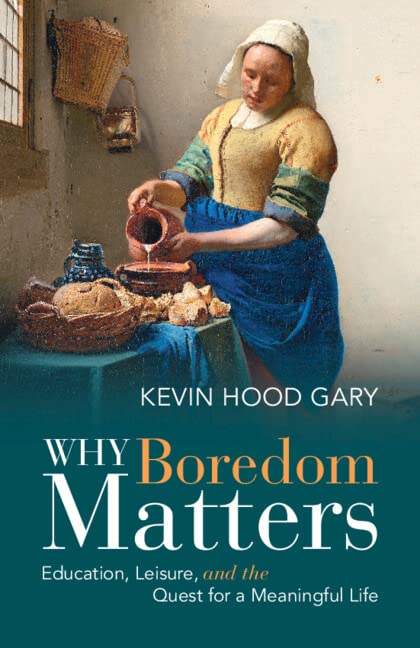Teachers and students deal with it all the time: boredom. And many people’s instinct is to avoid boredom, whether by turning to their smartphones or televisions or drinking or eating too much.
Kevin Hood Gary suggests that boredom avoidance isn’t the only — or best — way to deal with this mood state. Gary, a professor of education at Valparaiso University in Valparaiso, Indiana, argues that boredom isn’t just annoying; it’s morally fraught.
“To the extent that we’re letting ourselves be pushed and pulled around by boredom, we’re losing a careful engagement with the world,” he said.

In his new book, “Why Boredom Matters: Education, Leisure and the Quest for a Meaningful Life,” Gary argues that leisure is the antidote to boredom. He draws on classical and Christian thinkers, as well as movies such as “Groundhog Day” and examples from the classroom, to explore the notion of leisure, which he describes as “an art that requires discipline, vigilance, and practice.”
Gary has a Ph.D. in cultural and educational policy studies from Loyola University Chicago and an M.A. in systematic theology from the University of Notre Dame. He has taught high school and at Valparaiso University and Goshen College in Goshen, Indiana.
He spoke to Faith & Leadership’s Sally Hicks about boredom, leisure and human flourishing. The following is an edited transcript.
Faith & Leadership: How is a book about boredom and leisure a book about the quest for a meaningful life?

Kevin Hood Gary: To the extent that we are afflicted by boredom, we are not flourishing as human beings. We could have all kinds of material absolutes but still find life to be boring. We’re constantly toggling away from this mood state and not taking it on directly or thinking about how perhaps we should contend with it or challenge it or push through it.
We tend to respond in two ways. The simplest way is to avoid it; we find ways to get out of a boring situation. The simplest way is to pick up our phones, which are these sophisticated boredom-avoidance devices.
The other response is resignation. I’m thinking about this as someone who’s worked in teacher education and visited lots of classrooms. I was in a classroom a few years ago where the students were tasked with copying down a PowerPoint for 15 minutes. I was surprised the students were not pushing back.
I turned to one of the students and said, “Is this a typical day?”
And the student said, “We do this every day. We just copy notes down verbatim.”
What was striking to me was the resignation. The students were not checking their phones. They weren’t misbehaving. They had given up on there being a possibility for something meaningful here.
There was one student in that class who was doodling; they were basically creating art. And that was, for me, a sign of hope. They found a possibility for something meaningful in that context.
F&L: Is all boredom the same?
KHG: [German philosopher Martin] Heidegger makes a key distinction, which is applicable still, between situational and existential boredom.
Situational is just as it sounds: you’re in a situation that you find lacking in meaningful or engaging stimuli. Existential boredom is a boredom where you’re going from situation to situation to situation and you’re just not finding anything that is really grabbing your interest or moving your heart.
I’m interested in the context of school, because bored students’ grades tend to decline.
Bored students lose interest; they drop out at higher rates; they misbehave at much higher rates.
But boredom also is causally correlated with a number of other troubling behaviors — all kinds of addictions. We eat too much; we drink too much; we spend too much; we buy things we don’t need. There are companies that are built around our propensity to get bored; they actually want us to get bored so we upgrade to get the next phone, for example.
F&L: You see this problem of boredom as something much more important than simple annoyance. What is that deeper dimension?
KHG: In the ancient world, the word for it wasn’t quite the same, but it was trying to capture the same phenomenon. The word is “acedia,” which is something the monastics identified as one of the eight deadly thoughts, which then get translated into the seven deadly sins.
Acedia gets lumped in with sloth, and I think we lost something when we lost that as a distinctive thought. The root meaning of acedia, from the Greek word “kedos,” is care. It means a lack of care.
I argue that it’s morally fraught, and I’m drawing on the older understanding from this notion of acedia. To the extent that we’re moving into a state of acedia, or boredom, we’re on morally treacherous ground.
I mentioned some of these troubles, some addictions that we get drawn into. But even the subtler infractions, the half-listening to friends, checking our phones on the sly in a conversation — these are things that we’re doing when we’re not engaged.
F&L: What’s the relationship between boredom and depression?
KHG: There’s certainly a relationship there. When we’re in a bored state, there’s still a glimmer of hope that we can find a way out of it, that something will open up to us. To be clinically depressed is to lose that glimmer of hope. It’s a much more worrisome state.
F&L: The antidote to boredom, you argue, is leisure. What do you mean by that?
KHG: We know that amusement doesn’t renew us. But there’s this other way of being, which Aristotle says is the highest part of human flourishing: our capacity for leisure.
Aristotle says, “OK, there’s work, there’s amusement, but there’s this other sphere, which is leisure.” Leisure is not a passive receiving. When you think about activities that are noble forms of leisure, there’s both an active and a passive dynamic that’s going on.
Drawing from the Catholic philosopher Josef Pieper, the mind is both active and passive. It’s going for a walk where, on the one hand, you’re just taking it in. On the other hand, there’s an activity that’s required of you in a way that looking at a screen or amusement culture doesn’t require.
Playing a sport can be a place where leisure can happen. And part of the experience of leisure is appreciating the intrinsic value of the activity you’re doing; you’re not just doing it because you want to.
When you’re making a meal, that can be an experience of leisure; you’re actually enjoying the process as well as the fruit of the process. But that requires this vigilance, to get into a state of mind that’s both active and passive.
It’s a whole different way of being at leisure than the connotation of amusement culture today.
F&L: I was really struck by your example of Joanna Ziegler, a professor who had her students spend 13 weeks looking at the same painting in a museum. What’s happening there that’s not boredom but rather leisure?
KHG: Just to be clear, there’s going to be boredom. But the question is, “When do I push through? When do I engage it?”
First off, they had a choice. They could pick from three paintings. There’s something about agency that’s so critical. But they were then asked to sit with the painting each week for an hour and write a five-page essay.
Good works of art are saturated; we keep coming back to them. There’s always more to see; there’s more to notice. But it takes time and it takes patience and it takes careful attending and beholding to begin to experience the intrinsic value of these saturated phenomena.
What Joanna Ziegler did was create the conditions to nurture that beholding. It’s a pretty audacious assignment. By the end of the semester, that’s a painting that they’re never going to forget. To the extent that we can cultivate something that students behold and never forget, we’ve done something pretty extraordinary.
Playing an instrument is very tedious, but moving through that tedium then opens up ways of expressing and creating music that are incredibly enjoyable. You have to push through a malaise to get to this higher level of enjoyment.
With amusement culture, there’s no malaise, but the qualitative enjoyment is nowhere near the same. Watching five hours of “Friends” versus working on three chords and playing a song — there’s really no comparison for the quality.
I also want to say that I’m not saying we should have no amusement, that it should all be leisure and work, but rather that it should be put in its place. Aristotle described amusement as medicine. It helps you, but you don’t want to overdose on your meds either.
F&L: How do you teach people to manage boredom in a way that is fruitful?
KHG: There’s this idea of intrinsic motivation versus extrinsic. Extrinsic motivation is when we’re using carrots and sticks or grades or stickers to prompt students to pursue certain learning tasks. Intrinsic motivation is the student, from their own will and volition, choosing [a task].
The key is it’s not just intrinsic motivation. There’s a recognition of intrinsic value.
When I’m working on an equation in algebra, I’m beginning to value this extraordinary language, the beauty and the organization of it. Or I’m intrinsically fascinated by this era in history or this story in my English class. Good teachers are always striving to awaken that delight and the activity for its own sake.
Educationally, it’s thinking about what we’re doing as part of the cultivation of human flourishing, not just a preparation for the next level or status. That [challenge] even happens with things like music and sports, where they get so competitive that for the practitioners they’re no longer enjoyable.
The fundamental thing that we’re struggling with is attention, cultivating sustained meaningful attention. And that’s what the Ziegler art class was doing. Part of that requires limiting the range of options that they can attend to. I mentioned Joanna had just three paintings they could pick from: “Here are a few things, and you need to spend some time with these things.”
What we tend to do is give kids devices that have a million options. And so rather than a sustained deep attention, we flip from one thing to the next.
F&L: Do these concepts come from Christian theology or a religious outlook?
KHG: Yes. I was raised Catholic. I did my undergraduate degree at Notre Dame, and after graduating, I entered the seminary and studied to be a Catholic priest for four years.
For me, [the book] is definitely rooted in my own Catholic tradition, but I’m trying to write in a way that is speaking to a broader audience. But it certainly is inspired by works about contemplative prayer, my own attempts to engage in contemplative prayer.
In contending with the bored state, we need all the resources we can get. A story I share at the end of the book is about visiting my grandmother in a nursing home. Nursing homes can be pretty boring spaces. It was my love for my grandmother that helped me put that mood state in its place and just say, “This is an irrelevant mood state right now. I need to just be here and be present.”
In the movie “Groundhog Day,” it’s fascinating that initially [the Bill Murray character] is quite excited by all the possibilities of that day, where he can manipulate and live out his wildest dreams. But he moves from that into a profound existential boredom. And I think it’s a great metaphor for life.
He has to figure out the puzzle to get out of this existential boredom. And it is two things. One, it’s finding things that have intrinsic value. He begins to play piano; he begins to create art; he begins to read. Then he awakens to the idea that, “I actually need to care about and love other people.” That’s really where the puzzle gets unlocked.















